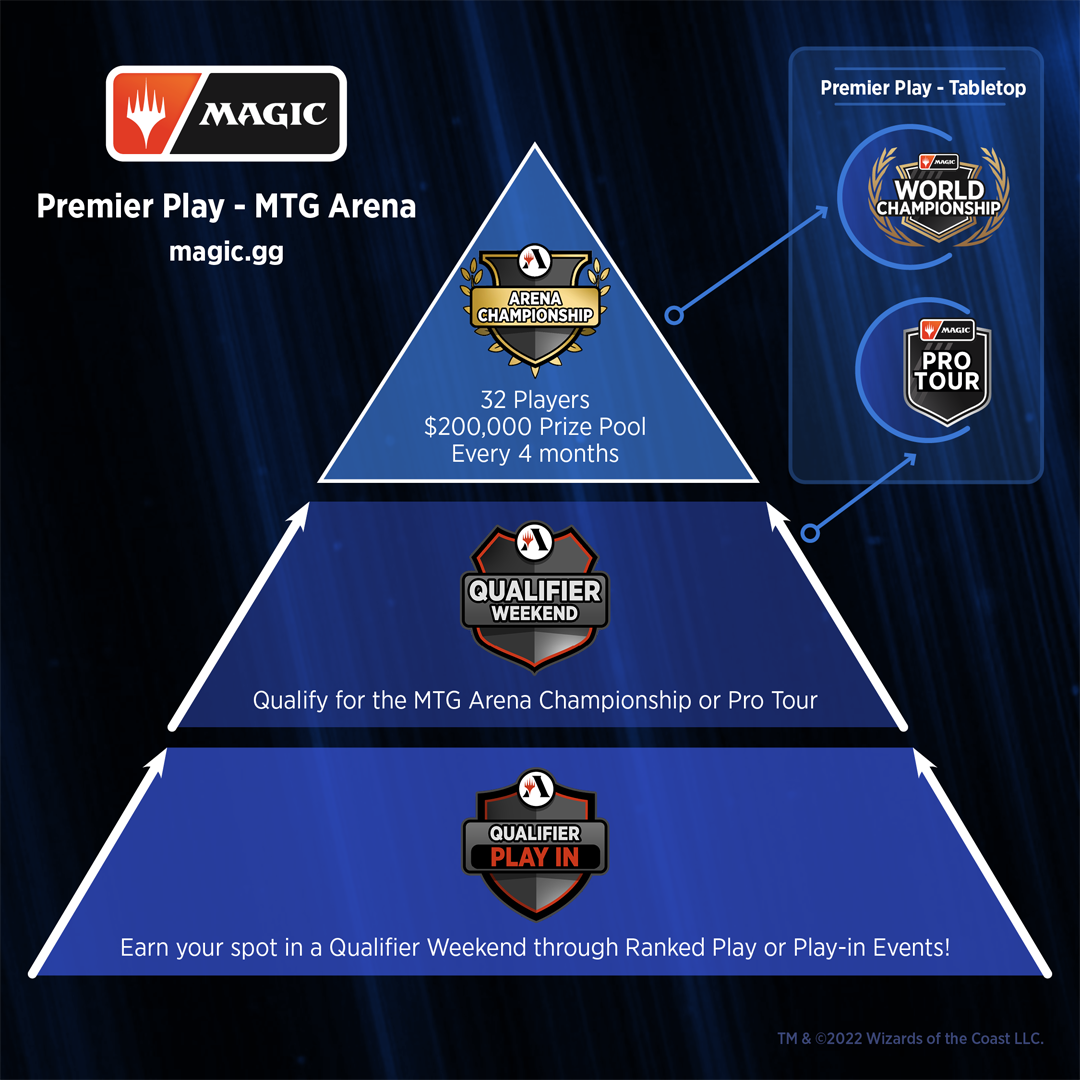It's almost here: Arena Championship 3 runs this weekend, May 27–28! In this prestigious tournament, which will be streamed live starting at 9 a.m. PT each day on twitch.tv/magic, 32 top MTG Arena players have brought their best Standard decks and will battle it out for $200,000 in prizes and two Magic World Championship XXIX invitations.
What Is the Arena Championship?
The Arena Championship, a thrice-yearly event, is the pinnacle of competition on MTG Arena. Previously in the 2022–23 season, Arena Championship 1 was won by Sam Rolph and Arena Championship 2 was won by Hiroshi Onizuka. The upcoming third edition invites players who earned the most wins across Qualifier Weekend Day Twos held in January, February, March, and April of this year.
To earn a spot in these monthly Qualifier Weekends, as described in more detail on the MTG Arena Premier Play page, there are various methods: by finishing in the Top 250 of the Constructed or Limited ladder at the end of the preceding month, by reaching enough wins in Day 2 of an Arena Open, or—most commonly—via a Qualifier Play-In event. During a Qualifier Weekend, it's quite an accomplishment to reach seven wins on Day One followed by even more wins on Day Two, but the payoff is worth it.
The list of qualified players for Arena Championship 3 is absolutely stacked with talent, featuring numerous Magic superstars:
- Reigning World Champion and Pro Tour champion Nathan Steuer
- Hall of Famer Seth Manfield
- 2020-21 Magic Pro League winner Ondřej Stráský
- Mythic Championship Cleveland 2019 runner-up Yoshihiko Ikawa
- Players Tour Nagoya 2020 champion Kenta Harane
- 2008 United States National champion Michael Jacob
- 2020 Season Grand Finals champion Austin Bursavich
- World Championship XXVIII competitor Jonny Guttman
Given the list of invited players, available on MTG Melee, I'm hyped to watch the event. This will be high-level Magic featuring some of the best players in the world, and if Nathan Steuer continues his streak of successive Top 8s, then he would set new records. After World Championship XXVIII, Pro Tour Phyrexia, and Pro Tour March of the Machine, Steuer could potentially go four-for-four!
Standard Metagame Breakdown
Day 1 of Arena Championship 3 leads off with March of the Machine Draft followed by three rounds of Standard Constructed. Day 2 features three more rounds of Standard Constructed with a cut to a Top 8 Standard Constructed playoff to determine the champion.
Standard is the most popular way to play Constructed on MTG Arena, and it recently took center stage at Pro Tour March of the Machine. There, Rakdos Midrange dominated the tournament, with the highest metagame share and win rate across all major archetypes. However, with such success comes a glaring bullseye on the deck's back. As competitors sought to uncover the hidden strategies and secret weapons that could dismantle the once-untouchable Rakdos titan, where did their deck choices for Arena Championship 3 end up?
| Deck Archetype | Number of Players | Percentage of Field |
|---|---|---|
| Rakdos Midrange | 9 | 28.1% |
| Jeskai Dragons | 5 | 15.6% |
| Five-color Ramp | 4 | 12.5% |
| Grixis Reanimator | 3 | 9.4% |
| Selesnya Enchantments | 2 | 6.3% |
| Rakdos Breach | 2 | 6.3% |
| Boros Midrange | 2 | 6.3% |
| Grixis Midrange | 2 | 6.3% |
| Orzhov Midrange | 1 | 3.1% |
| Mono-White Aggro | 1 | 3.1% |
| Azorius Soldiers | 1 | 3.1% |
All decklists will become available on the Arena Championship 3 event page after the event gets underway.
548443
541102
The most-played non-land cards at Arena Championship 3 are
There's no Esper Legends decks to prey upon, and everyone else came prepared with a plan. For example, Five-Color Ramp, Selesnya Enchantments, Orzhov Midrange, and Azorius Soldiers had a good matchup against the Bloodtithe-Fable decks at the Pro Tour, so they've surged in popularity and appear well-positioned in this field.
Invasion of Gobakhan
The biggest surprise was introduced by five daring individuals. Eager to shake the meta to its core, they embraced the challenge by arming themselves with an innovative Jeskai Dragons deck. This midrange deck harnesses the most potent cards available in white, blue, and red, and it exploits the powerful union of
"It's like the new
Standard Deck Summaries
To explain deck compositions in more detail, let me to briefly summarize and introduce all the archetypes one-by-one.
Rakdos Midrange (9 players): Rakdos Midrange puts together the most efficient interactive spells, creatures, and value engines available in black and red, with a mana base that supports
Jeskai Dragons (5 players): Jeskai Dragons features the usual suspects for a midrange deck, such as
Five-Color Ramp (4 players): Five-Color Ramp, also known as DinoMite, uses
Grixis Reanimator (3 players): Grixis Reanimator relies on
Selesnya Enchantments (2 players): Selesnya Enchantments can use
Rakdos Breach (2 players): Rakdos Breach is a midrange deck with a powerful top-end. The primary game plan is to use
Boros Midrange (2 players): Boros Midrange can be described as Mono-White Midrange with a red splash, using
Grixis Midrange (2 players): Grixis Midrange is similar to Rakdos Midrange. It accepts a slightly weaker mana base in exchange for access to blue cards like
Orzhov Midrange (1 player): Orzhov Midrange can be described as Mono-White Midrange with a black splash, using
Mono-White Aggro (1 player): This Mono-White Aggro brew combines
Azorius Soldiers (1 player): Azorius Soldiers leverages the best one-mana and two-mana Soldiers in blue and white for a synergistic assault. With
Cards from March of the Machine: The Aftermath did not make a large impact on this event. The only cards from the new set that were registered for Arena Championship 3 were four copies of
On the whole, Standard may still be dominated by
Find out live at twitch.tv/magic, starting 9 a.m. PT on May 27–28! Details can be found in the viewers guide.


